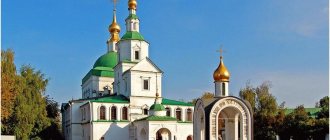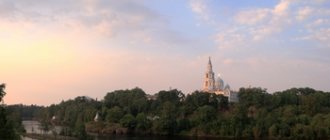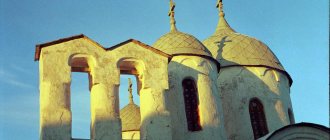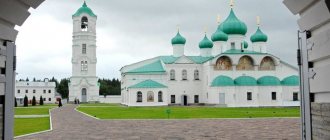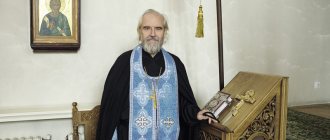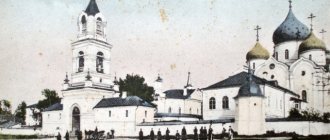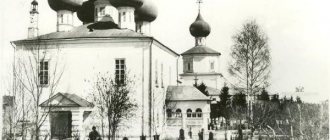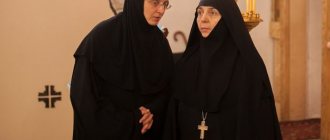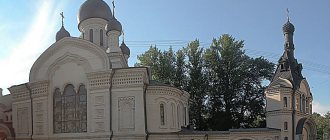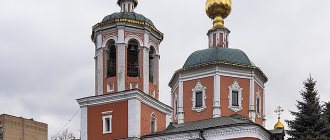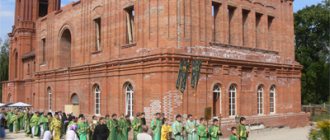The abbot of the Holy Dormition Monastery, Archimandrite Laurus, reposed in the Lord
Novomoskovsk, April 7, 2021
On Great Friday, on the eve of the Annunciation, Archimandrite Laurus, abbot of the Holy Dormition Monastery in the city of Novomoskovsk, Tula diocese, reposed in the Lord. He went to that better world together with Christ, when they buried the Lord, when tears were still welling up from that distant and close history that became the cornerstone of Orthodoxy. He left for that better world when it was quietly getting dark, when, walking behind the coffin, they quietly sang “Holy God”...
The life of Father Lavr was connected with the city of Novomoskovsk. He seemed to have grown into this once new Moscow, which existed without churches and a monastery, and changed the course of this strange habit of Soviet times and the Soviet city, the city of chemists. He was born on the Oka River, in the Aleksinskaya side. And everything, it seemed, was like everyone else’s, in the very middle of the twentieth century, a completely ordinary life: school, army. He served in Czechoslovakia and was a mechanic at one of the Tula factories. And then it all started in a not entirely trivial and standard way. He began to sing in the choir in the Church of the Twelve Apostles in Tula. This temple has never been closed. The Lord unfolded it as He pleased: the familiar and ordinary life was completed, a different one began, open to others, other paths and mentors appeared. He began to serve as a subdeacon with the Tula bishop Vladyka German (Timofeev), now Metropolitan of Volgograd and Kamyshin.
At the same time, as it now seems back in 1980, Bishop Herman organized one of the first diocesan celebrations on the occasion of the 600th anniversary of the victory of the Battle of Kulikovo. Then, years later, Father Laurus will become inseparable from this sacred first battlefield of Russia. He will be ordained a priest, become widowed, and become a monk. And then it will become necessary in many places of the ancient Tula land. He always fulfilled all obediences exactly. He prayed in the ancient Belev monastery, in the homeland of Vasily Andreevich Zhukovsky, the first romantic of our Fatherland. To some extent, Father Laurus was a romantic. After all, only romanticism and unwavering faith could make him an ascetic. He quickly moved throughout the Tula diocese, establishing churches in the late 80s and early 90s. He knew how to listen and tell quietly and calmly.
Father Laurus had a deep feeling and the power of conviction, but he kept it to himself, he did not declare anything, did not impose anything, but his kind of steadfastness, his example and simplicity convinced many that he was right. That's why people were drawn to him. Everything was without any embellishment, simple, nothing impossible was promised to anyone. But his kind of sincerity and, again, simplicity captivated both ordinary people and local leaders. He could find a common language with everyone. He was also known in the most remote parish in Chentsovo. He loved this place very much. With his participation, many churches were opened in Kurkinsky, Kimovsky and other districts of the region and, of course, the city of Novomoskovsk became dear to him. Father Laurus in the 90s began to establish a monastery here, as has already been noted, in a city where not only was there no intention of building churches, but the founding of a monastery here all the more seemed like some kind of illusion, some kind of dream. But then in the 90s many were romantics. And everyone believed it.
Of course, archpastors played a special role. Bishop Serapion (Fadeev +1999), he was then at the Tula See, blessed the construction of the monastery. Even then, it was bewildering that there would be a temple in the park of the city of chemists, in a cafe called “Lada”. But after some time it happened. On the outskirts of the city, which, thanks to Father Laurus, had long ceased to be an outskirts, a monastery began to be established. The first church was in honor of the Intercession of the Mother of God. Then they began to build the Assumption Cathedral. Then the devaluation of money occurred. Father Laurus was in a hurry with the construction site. And thanks to his natural and Tula tempering, he delved into every little detail. He began to build his monastery. And somehow the Lord arranged everything: the monastery appeared, the brethren gathered, the people came out. And Father Laurus, it seemed, had simply always been in this place. He was already here as a given, as a certain stability of this city, as a certain large part of it. Because - to paraphrase well-known words: we say Laurel, we represent Novomoskovsk and Kulikovo Field. His phone was ringing with the sounds of a censer. And when they called him, and a huge number of people called him until the last day, everyone heard “Holy Rus', keep the Orthodox faith.” He never pretended to be anything, never tried to be like anyone.
For almost 20 years, Father Laurus was the dean of the monasteries of the Tula diocese, he had a rare quality - the ability to feel sorry, not to judge, not to engage in didactics, but to put it simply. He was distinguished by his powerful figure, breadth of soul and joy of life. He loved her very much. Although for him his whole life was the Church. He did a lot. We don't fully understand this now. He was a real simple Russian priest...
The Lord took him away on the most sorrowful day of the year. The news spread quickly. He went to the Lord, with whom he was always and to whom he led many, many people. Father Laurus never saw any obstacles to the Lord, neither in Soviet times, nor in the 90s, nor after and until his last breath. Father Laurus will gather us all on Bright Monday in the monastery that he arranged and created.
LATEST COMMENTS
| Andrey: And these next 4 houses (and there are also 4 red houses +, apparently in the 3rd stage) will be... ⇒ Read more ⇐ |
| oMPLnyhusecrj: QEKCSTiNyDbp… ⇒ Read more ⇐ |
| Yelets goat: God grant that everything returns to normal!… ⇒ Read more ⇐ |
| Urino Coupe: I would like even more vaccination points, there is a very large increase in those interested!… ⇒ Read more ⇐ |
| Pavlukha: It’s very cool that such famous athletes come to our city... ⇒ Read more ⇐ |
LAUREL (KOROTKOV)
We became stronger, church life progressed according to your words published on the Official Portal of Yekaterinburg. RF: “...every church begins with the community: it is not the diocese that comes up with the idea of where to build a new church, but believers gather and take the initiative to build a church in one place or another, participate in the preparation of all the necessary documents and construction.”
Together with Priest Oleg Vokhmyanin, again with the blessing of Archbishop Vikenty of Yekaterinburg and Verkhoturye and Metropolitan Amfilohiy of Montenegro-Primorsky, we began to prepare documents for the construction of a temple on land allocated by the city. The administration of Yekaterinburg signed the Master Plan for the construction of a stone church in the name of St. Sava of Serbia. The authors of the project are Serbian architects Predrag and Sava Ristici.
On December 5, 2008, we began to build a wooden church in the name of St. Simeon the Myrrh-Streaming, King of Serbia, and “with the growth of the walls, parish life also increased, when the temple was built, church life ... became a completely natural continuation of the joint efforts of the community to build the church.” We build whenever possible—we don’t have rich people—that’s why we do it slowly. This circumstance did not upset us: everyone had time to participate, at least a little. Even the grandmothers, five people on each side, pulled the logs up with ropes. That’s why our friendship grew stronger because everyone got to know each other.
After Father Oleg was removed from his post as rector and Hieromonk Lavr Korotkov was appointed to this position, we soon learned that for some reason the documentation was being developed anew.
Six months ago we saw approximately the same sketch as you see above, and discovered that our wooden church in honor of St. Simeon the Myrrh-Streaming was not on it. There was no name of Saint Sava of Serbia, or rather, it was smeared with a black marker. There were no premises for parish life or activities for children. But we have many plans for organizing community life and raising children.
Hieromonk Laurus promised us that our wooden church would not be demolished: “after all, this is a people’s church, no one will touch it!” - this is how he answered our restless questions. And after he left, we discover a new sketch, which is presented here.
Nothing changed!! Only the clergy room has been enlarged.
It turns out that we were deceived.
A year has passed. The documentation is worth it.
And our General Plan was signed by the city and is still relevant today. The only church in Russia in the name of St. Simeon the Myrrh-Streaming King of Serbia is on this general plan. The only church in Russia in the name of St. Savva Serbsky is on this general plan. This general plan also contains the possibility of embodying community interests for organizing parish life.
We looked for and found budget solutions for future construction, which also make it possible to operate the temple complex energy-efficiently and independently of city networks. Obtaining permission from the city authorities to implement these ideas required a lot of effort. With God's help, permission was obtained. But the new sketches don’t even show this.
But what upsets us most is that no one asked us anything, as if there was no parish community.
But the old Russian proverb says: “The Church is not in logs, but in ribs.”
How so, Vladyko?
And yet, our parish lives with thoughts of building a church in the name of St. Sava of Serbia.
Parishioners of the Bishop's Compound in the name of St. Savva of Serbia and the Church of St. Simeon the Myrrh-Streaming, King of Serbia, Yekaterinburg, ZhBI microdistrict.
+ + + + + + + + + + + + + + + + + + + + + + + + + + + + + + + + + + + + + + + + + + + + + + + + + + + + + + + + + + + + + + + + + + + + + + + + + + + + + + + + + + + + +[ad01]
The head of the region's main monastery died in the Urals. "He was only thirty years old"
As noted on the official website of the seminary, “at the Yekaterinburg Theological Seminary he proved himself to be a responsible and diligent leader, a kind, sympathetic and attentive vice-rector, who always tried to put himself in the position of a student. Father Laurus put a lot of effort into decorating the new seminary building near the Trinity Cathedral.”
In 2014, he was transferred to the position of head of the Correspondence Education Sector of the Yekaterinburg Theological Seminary. Significant efforts were made to conveniently locate the Sector in Pilgrim.
On October 22, 2015, he was appointed abbot of the St. Nicholas Verkhoturye Monastery. On December 31 of the same year, he was elevated to the rank of abbot by Metropolitan Kirill (Nakonechny) of Yekaterinburg and Verkhoturye in the Cathedral of the Exaltation of the Cross of the St. Nicholas Monastery.
He paid great attention to church services, always performing the service calmly and prayerfully. He was not afraid of work, working and decorating the temple along with everyone else.
He died at dawn on June 25, 2016, at the age of 30, after a serious illness. He was buried behind the altar of the Transfiguration Church of the Verkhoturye Monastery.
Used materials
Appeal to the Metropolitan -
07/10/2015 Appeal to the Metropolitan
TO HIS EMPLOYMENT THE MOST REPRESENTATIVE KIRILL, METROPOLITAN OF EKATERINBURG AND VERKHOTURE
Your Eminence, dear Vladyka!
The parish of the Bishop's Compound in the name of St. Sava of Serbia and the Church of St. Simeon the Myrrh-Streaming, King of Serbia (Ekaterinburg, ZhBI microdistrict) has existed since 2003.
Then we performed divine services in the class of the Slavic school, and with the blessing of Archbishop Vikenty of Yekaterinburg and Verkhoturye, the temple was given a name in honor of the enlightener of the Serbian people, Saint Sava of Serbia. A year later, on January 25, 2004, on the Day of Remembrance of St. Sava of Serbia, the church was visited by Archbishop of Yekaterinburg and Verkhoturye Vincent and Metropolitan Amfilohiy of Montenegro-Primorsky.
In 2005, when the school building was transferred to a kindergarten, a new “nomadic life” began for the parish. Liturgies were held in the apartments of our parishioners, then in the deputy center of City Duma deputy L.I. Kovpak, and a few months later - again in the apartments.
The ordeal lasted three years, but the experience only united us, the parishioners.
